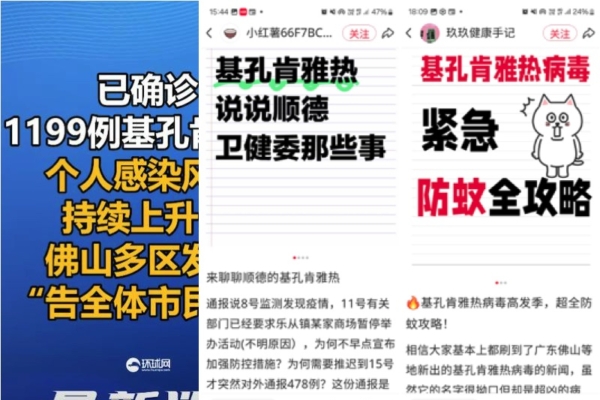Recently, the Guangdong Provincial Center for Disease Control and Prevention in mainland China announced the emergence of a new epidemic called “Chikungunya fever” in Foshan and other areas. Approximately over a thousand cases have been confirmed in about 10 days with mosquitoes being the medium of transmission. The police have been conducting door-to-door isolation measures, and the public is dissatisfied with the delayed official notification.
Foshan Shunde District Health Bureau first reported on July 15 that an outbreak of “Chikungunya fever” imported from overseas was discovered on July 8. As of the 15th, there were 478 confirmed cases in the entire district.
According to a report by mainland China’s Global Network on TikTok on July 19, there have been 1,193 confirmed cases. The personal infection risk is continuing to increase. Various areas in Foshan have issued a notice to all citizens. The notice stated: “In order to quickly reduce mosquito density and maximize efforts to interrupt the spread of the epidemic, we are calling on all units, schools, construction sites, villages (communities), families, and all citizens in the entire district to carry out a patriotic health movement focusing on clearing mosquito breeding sites and eliminating adult mosquitoes on July 19-20 (this weekend).
Local residents have expressed dissatisfaction with the delay in reporting the epidemic from its discovery by the disease control authorities. Some questioned why stronger control measures were not announced earlier and why it was delayed until the 15th to suddenly report 478 cases to the public.
Residents pointed out the significant delay between the discovery of the epidemic on the 8th and the public notification on the 15th, which clearly exceeds the 24-hour requirement of the Infectious Disease Prevention and Control Law. Some even mentioned instances of past concealment of actual infection numbers during previous outbreaks like dengue fever.
Patients in the area have also confirmed this sentiment, mentioning their observations of many people being affected by the outbreak, indicating the severity of the situation.
Public information indicates that “Chikungunya fever” is a viral infectious disease related to dengue fever, primarily spread by the Aedes mosquitoes. The symptoms include sudden high fever, severe joint pain (to the point of immobilization), rash, accompanied by chills, and headaches. Currently, there is no vaccine or specific treatment available.
Doctors have created comparison tables for educational purposes to raise awareness about the disease.
A female patient from Foshan shared her experience on social media, mentioning that she initially had sporadic rashes and joint pain on July 6. She sought medical attention on July 7, was diagnosed with acute urticaria. The situation worsened with increasing rashes and conjunctivitis on July 9, eventually leading to a diagnosis of Chikungunya fever on July 10 after severe symptoms worsened.
She emphasized her struggle with the disease and the discrepancies between her timeline and the official reports. Some locals voiced concerns over the lack of detailed investigations by the authorities, emphasizing the need for thorough contact tracing.
Furthermore, the patient described a harrowing experience of being isolated in a hospital room after a delay in response from the disease control center. She questioned the effectiveness of such measures and the proper allocation of healthcare resources.
Other residents in the area shared similar concerns, with one expressing worries about potential forced hospitalization even after recovery from fever. The lack of communication and coordination during the outbreak response raised doubts among the community about the government’s handling of the situation.
Given the simultaneous spread of “Chikungunya fever” and dengue fever in Guangdong, medical records suggest the possibility of dual infections in individuals. Communities in Guangzhou are actively promoting preventative measures against dengue fever, including areas like Tianhe and Panyu.
While Chikungunya fever has a low mortality rate, a specialist from the Zhejiang Traditional Chinese Medicine Hospital warned about the current risks posed by the weather conditions, which are conducive for mosquito breeding. Therefore, proactive measures to eliminate mosquito breeding sites and personal protection are crucial in preventing the spread of mosquito-borne diseases like Chikungunya fever and dengue fever. Remembering life-saving tips such as overturning stagnant water containers, using insect repellents, and wearing appropriate clothing can help reduce the risk of mosquito bites and subsequent infections.
In light of the ongoing health crisis, local residents are advised to stay vigilant, seek medical attention promptly if experiencing symptoms such as fever and joint pain after mosquito bites, and adhere to preventive measures to safeguard their health and well-being.

